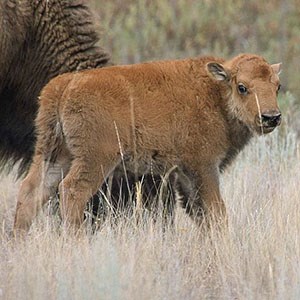Last updated: April 6, 2018
Article
Bison Bellows: Birth Synchrony - Why Now?

Photo courtesy of Steve Hillebrand
Did you know that 80% of bison calves have April and May birthdays? This is because of something called birth synchrony. Birth synchrony is considered an evolutionary adaptation where adult females give birth during a focused period of time during a specific season, often called the birthing season. This phenomenon is seen globally for many wildlife, such as corals, fish, birds, and some ungulates. For bison, the birthing season is often referred to as the "calving season." Research has documented that the bison calving season often occurs between mid-April to early-July, across multiple herds in different locations, and with many births concentrated within only several weeks. For example, one study showed that at Wind Cave National Park, 95% of bison calves were born within a 40 day time-span from mid-April to late May.
Why would this happen? Some scientists think birth synchrony occurs in bison due to strong seasonal limitations on food availability and quality, so that females enter estrus as a group depending on when their physical condition recovers from a long period of food stress that they all go through together. In this case, when green grass is limited to only a relatively short period of time, birth synchrony would be expected to be more focused than when green grass is available for a longer period of time. This reason could also explain why birth synchrony occurs just prior to peak green grass availability, when the mother would have access to the best food of the year, and thereby optimize her milk production following birth, thus benefiting her calf nutrition and growth.

NPS Photo
Another consideration is that birth synchrony occurs in order to increase the chance of survival for individual newborn wildlife in the presence of predators. Under this scenario, an individual calf would potentially have a higher chance of survival if it was born amongst a larger group of calves, than if it was born alone, say in the face of wolf or bear predation. Birth synchrony can also be explained amongst herding animals like bison, wherein a larger number of simultaneously ovulating females makes it harder for any one male to monopolize breeding – and thus competition amongst males is stronger and paternity is distributed more widely across the total male population, thereby increasing the overall genetic fitness of the population. Wow! Who knew that the bison calving season could have so many underlying causes?
What is clear is that birth synchrony does occur across the bison historic range, and the phenomenon is likely based on several simultaneously contributing causes. Beyond the underlying ecological reasons, birth synchrony means that friends of bison at national parks and refuges can plan their visits in the spring and early summer, knowing they can look forward to seeing lots of red bison calves! You can learn more about bison birth synchrony by reading "Birth Synchrony in American Bison (Bison bison): Response to Predation or Season?" by Allen Rutberg, as published by the American Society of Mammalogists and available online.
Read more Bison Bellows here.
